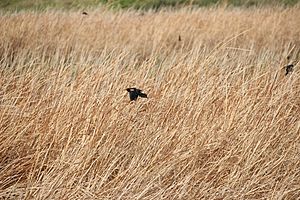Tricolored blackbird facts for kids
Quick facts for kids Tricolored blackbird |
|
|---|---|
 |
|
| A male tricolored blackbird in California, United States | |
| Conservation status | |
| Scientific classification | |
| Genus: |
Agelaius
|
| Species: |
tricolor
|
 |
|
| range of Tricolored blackbird | |
The tricolored blackbird (Agelaius tricolor) is a type of passerine bird. It belongs to the Icteridae family, which includes other blackbirds and orioles. These birds live along the Pacific coast of North America. You can find them from Northern California in the U.S. down to Baja California in Mexico. Sometimes, they might even visit Oregon.
Tricolored blackbirds are very social birds. They live in huge groups, forming the biggest colonies of any land bird in North America. A single breeding colony can have tens of thousands of birds!
The male bird has special red patches on its shoulders. These patches have white stripes at the bottom. This is why they are called "tricolored." You can easily see these stripes when the bird flies or shows off.
Even though it has "blackbird" in its name, this bird is not related to the common blackbird found in other parts of the world. That bird is a thrush.
The tricolored blackbird has unique calls. Its call sounds a bit like a nasal kip or a sharp check. The male's song is a jumbled on-ke-kaaangh. These birds travel south to Mexico during colder times. When the weather gets warmer, they fly back to northern California.
Contents
Why are Tricolored Blackbirds Endangered?
The tricolored blackbird is facing serious challenges. Its numbers have dropped a lot over the years. Because of this, it is now considered an endangered species.
How Did They Become Endangered?
In 1990, the California Department of Fish and Game noticed that the number of tricolored blackbirds was going down. They put the bird on a list of "Bird Species of Special Concern." This was a warning to people who manage land that the bird needed extra help. The U.S. Fish and Wildlife Service also added it to their list of Birds of Conservation Concern.
By 1991, there were only about 35,000 adult tricolored blackbirds left. This worried many people. The National Audubon Society asked the California Fish and Game Commission to consider the bird endangered. For a short time, it was listed as endangered.

Then, in 1992, researchers found a much larger population. There were over 300,000 adult birds! So, the endangered status was removed. People hoped that new plans would be made to protect the birds. However, not much progress was made to stop their numbers from dropping again.
After the year 2000, groups started looking at the birds' population again. They found that the numbers were still going down.
In 2006, BirdLife International officially called the tricolored blackbird "Endangered." This made it a big concern for both the local area and the whole country.
What Makes Them Vulnerable?
Tricolored blackbirds are very social and live in large groups. This makes them easy targets for problems. For example, if something bad happens to one colony, it can affect many birds at once. This is similar to what happened to the extinct passenger pigeon.
One big problem is that the places where they used to nest and find food are disappearing. These native grasslands are being turned into cities and farms.
Also, some birds started nesting in farm fields. But when farmers harvest their crops during the breeding season, it disturbs the birds. This can cause them to abandon their nests.
Protecting Their Habitat
To help the tricolored blackbird, several important steps are being taken. The U.S. Fish and Wildlife Service has a plan with these main goals:
- Keep, improve, and protect the places where they live, nest, find food, and spend the winter.
- Create new safe places for them to breed and find food.
- Find ways to make sure these nesting and feeding areas are protected.
- Survey private lands to find the largest and most vulnerable colonies.
- Encourage landowners to protect active breeding colonies on their property.
- Encourage and improve breeding colonies on public lands.
Images for kids
See also
 In Spanish: Sargento tricolor para niños
In Spanish: Sargento tricolor para niños



